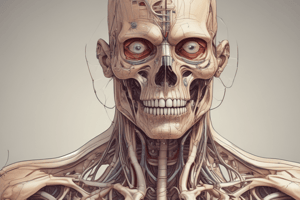Podcast
Questions and Answers
What is the function of acetylcholine in the neuromuscular junction?
What is the function of acetylcholine in the neuromuscular junction?
- To release neurotransmitters in the synaptic cleft (correct)
- To store adenosine triphosphate
- To bind to receptors on the presynaptic membrane
- To store oxygen for cellular respiration
Which of the following is NOT a part of a neuromuscular junction?
Which of the following is NOT a part of a neuromuscular junction?
- A space filled with synovial fluid (correct)
- The end of a single nerve cell which touches the sarcolemma of the muscle fibre
- The synaptic cleft - a fluid-filled space
- The sarcolemma of the muscle fibre
What is the process by which acetylcholine is released from the synaptic vesicles?
What is the process by which acetylcholine is released from the synaptic vesicles?
- Diffusion
- Osmosis
- Endocytosis
- Exocytosis (correct)
What is required for muscle contraction?
What is required for muscle contraction?
Where is acetylcholine bound in the neuromuscular junction?
Where is acetylcholine bound in the neuromuscular junction?
What is the correct description of the neuromuscular junction?
What is the correct description of the neuromuscular junction?
Which of the following statements accurately describes the release of neurotransmitters?
Which of the following statements accurately describes the release of neurotransmitters?
What is the role of acetylcholine in the nervous system?
What is the role of acetylcholine in the nervous system?
Which of the following statements about serotonin is TRUE?
Which of the following statements about serotonin is TRUE?
Which of the following neurotransmitters is known to inhibit the activity of certain neurons?
Which of the following neurotransmitters is known to inhibit the activity of certain neurons?
Which of the following neurotransmitters belong to the class of catecholamines?
Which of the following neurotransmitters belong to the class of catecholamines?
Which of the following statements BEST describes the function of excitatory postsynaptic potentials (EPSPs)?
Which of the following statements BEST describes the function of excitatory postsynaptic potentials (EPSPs)?
What is the primary function of the myelin sheath in the nervous system?
What is the primary function of the myelin sheath in the nervous system?
What is the process by which a neuron receives and transmits a signal?
What is the process by which a neuron receives and transmits a signal?
Which statement about reflex acts is true?
Which statement about reflex acts is true?
What describes a resting neuron?
What describes a resting neuron?
What initiates a nervous impulse?
What initiates a nervous impulse?
What is the correct definition of a synapse?
What is the correct definition of a synapse?
What term describes the synapse between a neuron and a muscle cell?
What term describes the synapse between a neuron and a muscle cell?
Which statement about neurotransmitters is accurate?
Which statement about neurotransmitters is accurate?
Which is part of the process of generating an action potential?
Which is part of the process of generating an action potential?
Which component is NOT involved in the resting state of a neuron?
Which component is NOT involved in the resting state of a neuron?
Flashcards are hidden until you start studying
Study Notes
Reflex Act
- A reflex act can be automatic and unconscious without involving the encephalon or a mental activity
- A typical example of a reflex act is the patellar reflex
- The reflex act represents the anatomic base of certain neural circuits
Resting Neuron
- A resting neuron is polarised because the internal and external surface of its membrane have opposite electrical charges
- Its cytoplasm has a negative electric charge, and the external surface of its membrane has a positive electric charge
Nervous Impulse
- A nervous impulse originates in an electrochemical event triggered by the altered ion distribution in the nerve cell
- It is transmitted and is also called action potential
- When it is generated, a stimulus changes the resting potential by opening sodium channels and allowing the passage of sodium ions into the nerve cell
Synapse
- A synapse is the junction between two neurons (a presynaptic one and a postsynaptic one)
- The synapse between a neuron and a muscle cell is called a neuromuscular synapse or neuromuscular junction
Neurotransmitters
- Neurotransmitters are chemical substances belonging to different classes of compounds (catecholamines, amino acids, etc.)
- They are released from the terminal buttons of the presynaptic neuron axon and cross the synaptic gap
- Their connection to the postsynaptic membrane receptors generates an action potential in the postsynaptic neuron
- Acetylcholine is released by neurons which innervate skeletal muscles at the point of the neuromuscular junction
- Serotonin is a neurotransmitter present both in the encephalon and in the spinal cord, involved in certain mental functions or in the circadian rhythm
- Gamma aminobutyric acid (GABA) and glycine can inhibit the activity of certain neurons
- Dopamine, noradrenaline, and adrenaline belong to the class of catecholamines
Neuromuscular Junction
- A neuromuscular junction consists of the end of a single nerve cell which touches the sarcolemma of the muscle fibre
- Acetylcholine is released in the synaptic cleft of the neuromuscular junction and binds to the receptors on the cellular membrane of the muscle fibre (sarcolemma)
- Muscle contraction requires acetylcholine as a neurotransmitter and adenosine triphosphate
Studying That Suits You
Use AI to generate personalized quizzes and flashcards to suit your learning preferences.



